Influence of Sputtering Power on the Properties of Magnetron Sputtered Tin Selenide Films
Abstract
:1. Introduction
2. Materials and Methods
3. Results and Discussion
3.1. X-ray Diffraction
3.2. Scanning Electron Microscopy
3.3. Thermoelectric Properties
3.3.1. Electrical Conductivity
3.3.2. Seebeck Coefficient
3.3.3. Thermal Conductivity
3.3.4. Thermoelectric Figure of Merit (ZT)
3.4. Analysis of Electrical Signals of the Sputtering Power Source
4. Conclusions
Author Contributions
Funding
Institutional Review Board Statement
Informed Consent Statement
Data Availability Statement
Acknowledgments
Conflicts of Interest
References
- Zhao, L.D.; Lo, S.H.; Zhang, Y.; Sun, H.; Tan, G.; Uher, C.; Wolverton, C.; Dravid, V.P.; Kanatzidis, M.G. Ultralow Thermal Conductivity and High Thermoelectric Figure of Merit in SnSe Crystals. Nature 2014, 508, 373–377. [Google Scholar] [CrossRef] [PubMed]
- Sist, M.; Zhang, J.; Iversen, B.B. Crystal Structure and Phase Transition of Thermoelectric SnSe. Acta Crystallogr. Sect. B Struct.Sci. Cryst. Eng. Mater. 2016, 72, 310–316. [Google Scholar] [CrossRef] [PubMed]
- Jin, M.; Jiang, J.; Li, R.; Wang, X.; Chen, Y.; Zhang, R.; Chen, Y. Growth of Large Size SnSe Single Crystal and Comparison of Its Thermoelectric Property with Polycrystal. Mater. Res. Bull. 2019, 114, 156–160. [Google Scholar] [CrossRef]
- Nandihalli, N. Thermoelectric Films and Periodic Structures and Spin Seebeck Effect Systems: Facets of Performance Optimization. Mater. Today Energy 2022, 25, 100965. [Google Scholar] [CrossRef]
- Hou, S.; Li, Z.; Xue, Y.; Ning, X.; Wang, J.; Wang, S. Surprisingly High In-Plane Thermoelectric Performance in a-Axis-Oriented Epitaxial SnSe Thin Films. Mater. Today Phys. 2021, 18, 100399. [Google Scholar] [CrossRef]
- Boscher, N.D.; Carmalt, C.J.; Palgrave, R.G.; Parkin, I.P. Atmospheric Pressure Chemical Vapour Deposition of SnSe and SnSe2 Thin Films on Glass. Thin Solid Film. 2008, 516, 4750–4757. [Google Scholar] [CrossRef]
- Drozd, V.E.; Nikiforova, I.O.; Bogevolnov, V.B.; Yafyasov, A.M.; Filatova, E.O.; Papazoglou, D. ALD Synthesis of SnSe Layers and Nanostructures. J. Phys. D Appl. Phys. 2009, 42, 125306. [Google Scholar] [CrossRef]
- Barrios-Salgado, E.; Nair, M.T.S.; Nair, P.K. Chemically Deposited SnSe Thin Films: Thermal Stability and Solar Cell Application. ECS J. Solid State Sci. Technol. 2014, 3, Q169–Q175. [Google Scholar] [CrossRef]
- Engelken, R.D.; Berry, A.K.; Van Doren, T.P.; Boone, J.L.; Shahnazary, A. Electrodeposition and Analysis of Tin Selenide Films. J. Electrochem. Soc. 1986, 133, 581–585. [Google Scholar] [CrossRef]
- Mariappan, R.; Ragavendar, M.; Gowrisankar, G. Growth and Characterization of SnSe Thin Films Prepared by Spray Pyrolysis Technique. Chalcogenide Lett. 2010, 7, 211–216. [Google Scholar]
- Ganesan, N.; Sivaramakrishnan, V. The Influence of Gas Adsorption and Temperature on the Electrical Resistivity of SnSe Thin Films. Semicond. Sci. Technol. 1987, 2, 519–523. [Google Scholar] [CrossRef]
- Terada, T. Vacuum Deposition of Tin-Selenium Films. J. Phys. D Appl. Phys. 1971, 4, 1991. [Google Scholar] [CrossRef]
- Kim, S.K.; Choi, S.Y. Phase Change Characteristics of SnX Se100-X Thin Films by RF-Magnetron Sputtering. Korean, J. Mater. Res. 2009, 19, 203–206. [Google Scholar] [CrossRef]
- Singh, J.P. Transport and Optical Properties of Hot-Wall-Grown Tin Selenide Films. J. Mater.Sci. Mater. Electron. 1991, 2, 105–108. [Google Scholar] [CrossRef]
- Guillén, C.; Montero, J.; Herrero, J. Characteristics of SnSe and SnSe2 Thin Films Grown onto Polycrystalline SnO 2-Coated Glass Substrates. Phys. Status Solidi (A) Appl. Mater. Sci. 2011, 208, 679–683. [Google Scholar] [CrossRef]
- Song, L.; Zhang, J.; Iversen, B.B. Enhanced Thermoelectric Properties of SnSe Thin Films Grown by Single-Target Magnetron Sputtering. J. Mater. Chem. A 2019, 7, 17981–17986. [Google Scholar] [CrossRef]
- Chen, Z.J.; Shen, T.; Nutor, R.K.; Yang, S.D.; Wu, H.F.; Si, J.X. Influence of Local Heterojunction on the Thermoelectric Properties of Mo-SnSe Multilayer Films Deposited by Magnetron Sputtering. J. Electron. Mater. 2019, 48, 1153–1158. [Google Scholar] [CrossRef]
- Linseis. Thin Film Analyzer-TFA Thermal Analysis. 2018. Available online: https://www.linseis.com/wp-content/uploads/2020/09/Linseis-TFA-Thin-Film-Analyzer-for-Thermal-Analysis-v4.pdf (accessed on 1 June 2024).
- Linseis, V.; Völklein, F.; Reith, H.; Nielsch, K.; Woias, P. Instrumentation for the Characterization of Materials & Modules. Rev. Sci. Instrum. 2020, 89, 015110. [Google Scholar] [CrossRef]
- Wang, F.Q.; Zhang, S.; Yu, J.; Wang, Q. Thermoelectric Properties of Single-Layered SnSe Sheet. Nanoscale 2015, 7, 15962–15970. [Google Scholar] [CrossRef] [PubMed]
- Le, M.T.; Sohn, Y.U.; Lim, J.W.; Choi, G.S. Effect of Sputtering Power on the Nucleation and Growth of Cu Films Deposited by Magnetron Sputtering. Mater. Trans. 2010, 51, 116–120. [Google Scholar] [CrossRef]
- Burton, M.R.; Liu, T.; McGettrick, J.; Mehraban, S.; Baker, J.; Pockett, A.; Watson, T.; Fenwick, O.; Carnie, M.J. Thin Film Tin Selenide (SnSe) Thermoelectric Generators Exhibiting Ultralow Thermal Conductivity. Adv. Mater. 2018, 30, 1801357. [Google Scholar] [CrossRef] [PubMed]
- Shi, W.; Gao, M.; Wei, J.; Gao, J.; Fan, C.; Ashalley, E.; Li, H.; Wang, Z. Tin Selenide (SnSe): Growth, Properties, and Applications. Adv. Sci. 2018, 5, 1700602. [Google Scholar] [CrossRef] [PubMed]
- Chen, C.L.; Wang, H.; Chen, Y.Y.; Day, T.; Snyder, G.J. Thermoelectric Properties of P-Type Polycrystalline SnSe Doped with Ag. J. Mater. Chem. A 2014, 2, 11171–11176. [Google Scholar] [CrossRef]
- Morales Ferreiro, J.O.; Diaz-Droguett, D.E.; Celentano, D.; Reparaz, J.S.; Sotomayor Torres, C.M.; Ganguli, S.; Luo, T. Effect of the Annealing on the Power Factor of Un-Doped Cold-Pressed SnSe. Appl. Therm. Eng. 2017, 111, 1426–1432. [Google Scholar] [CrossRef]
- Tian, B.; Liu, Z.; Zhang, Z.; Liu, Y.; Lin, Q.; Peng, S.; Jiang, Z. Effect of Film Deposition Rate on the Thermoelectric Output of Tungsten-Rhenium Thin Film Thermocouples by DC Magnetron Sputtering. J. Micromechanics Microengineering 2020, 30, 065004. [Google Scholar] [CrossRef]
- Sinnarasa, I.; Thimont, Y.; Presmanes, L.; Bonningue, C.; Barnabé, A.; Tailhades, P. Influence of Thickness and Microstructure on Thermoelectric Properties of Mg-Doped CuCrO 2 Delafossite Thin Films Deposited by RF-Magnetron Sputtering. Appl. Surf. Sci. 2018, 455, 244–250. [Google Scholar] [CrossRef]
- Wang, C.; Li, Y.D.; Zhang, G.H.; Zhuang, J.; Shen, G.Q. Synthesis of SnSe in Various Alkaline Media under Mild Conditions. Inorg. Chem. 2000, 39, 4237–4239. [Google Scholar] [CrossRef]

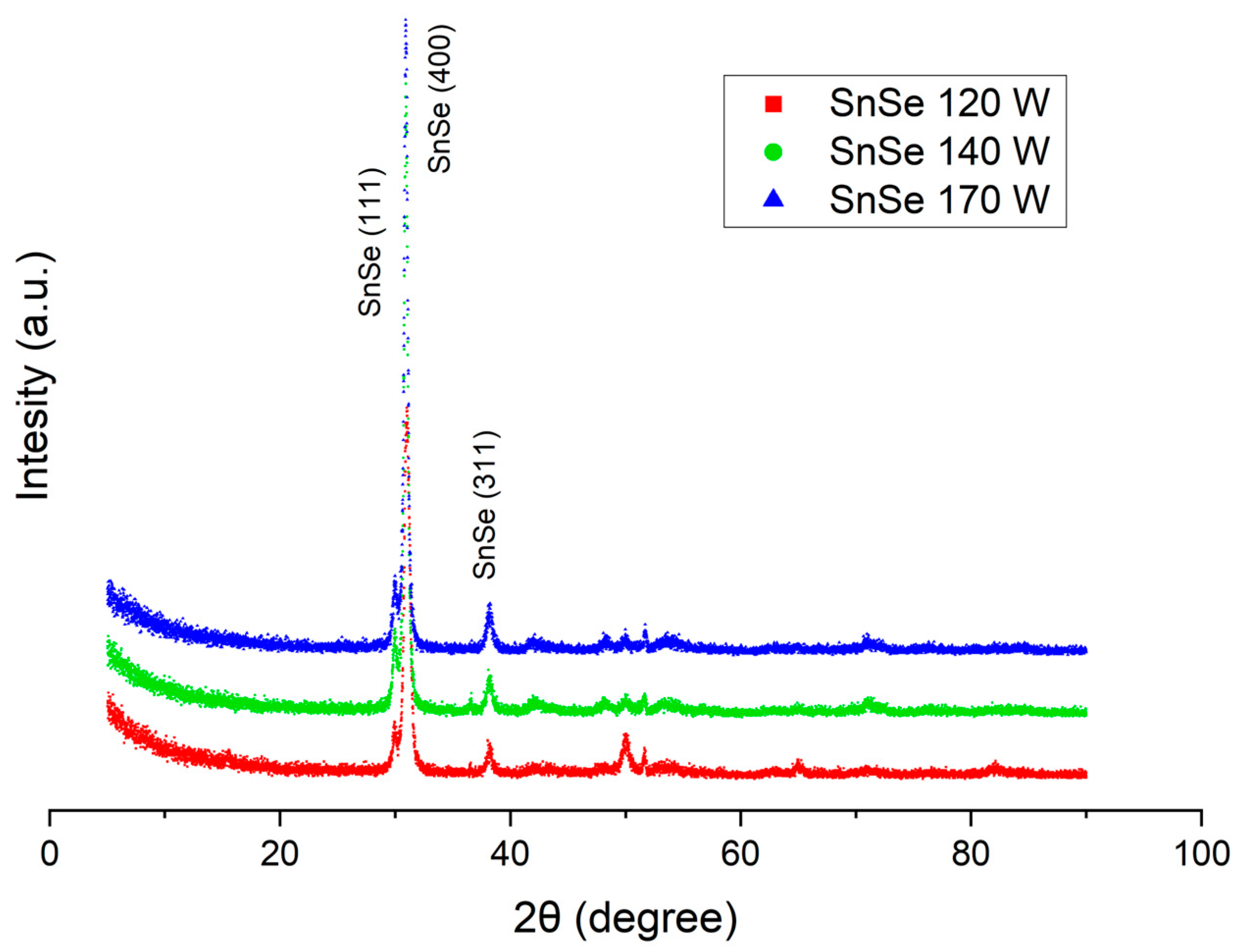

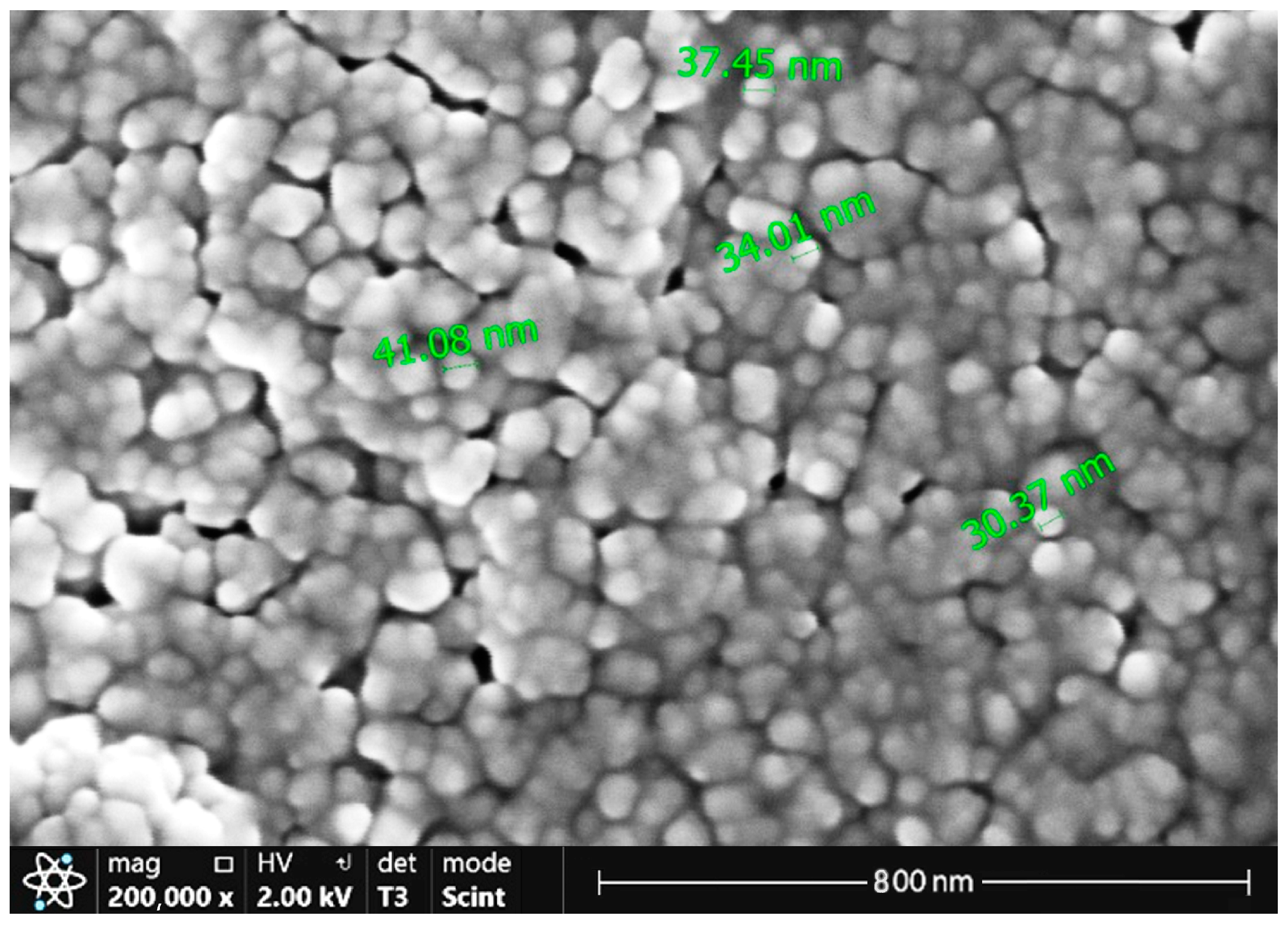

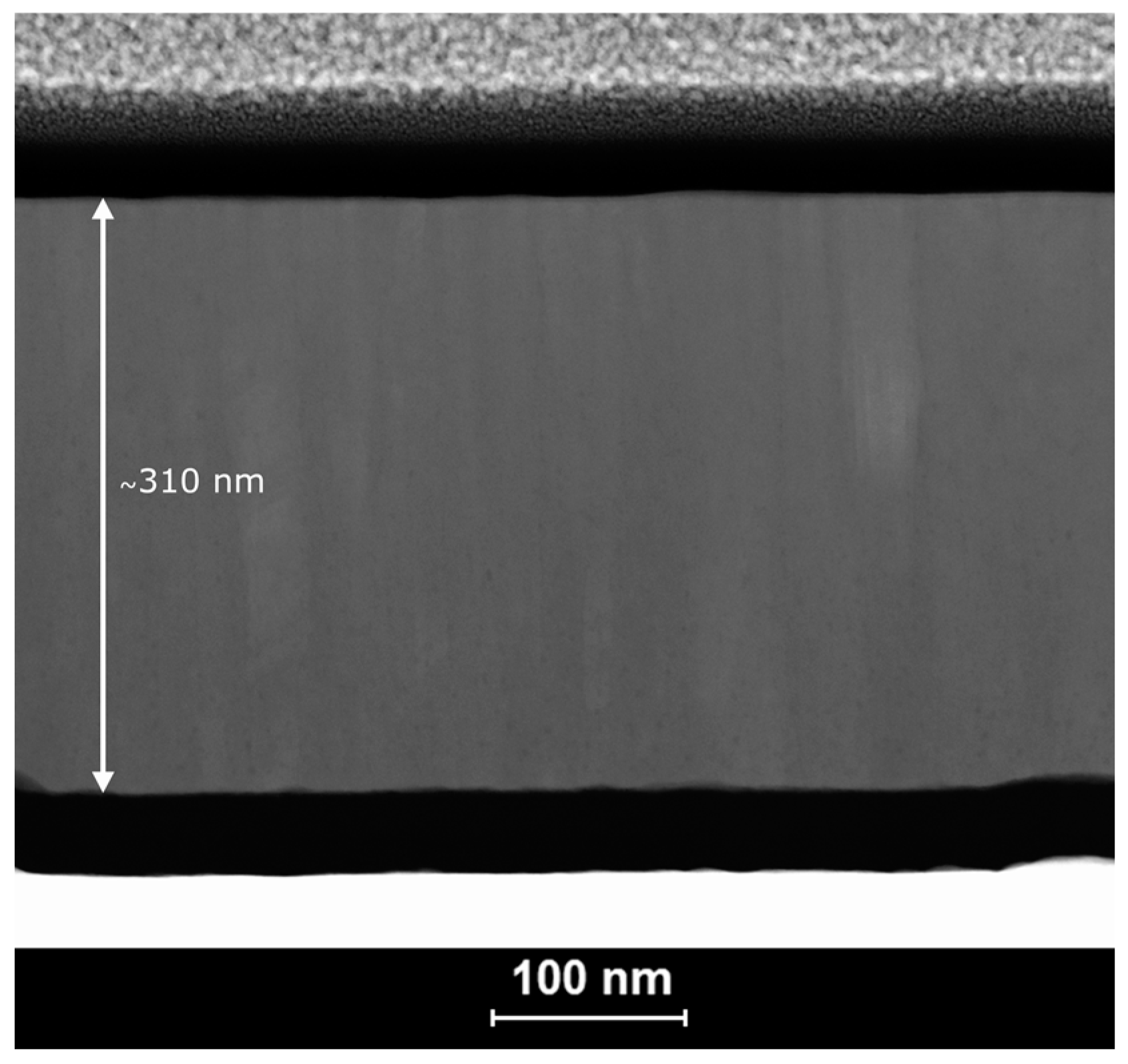

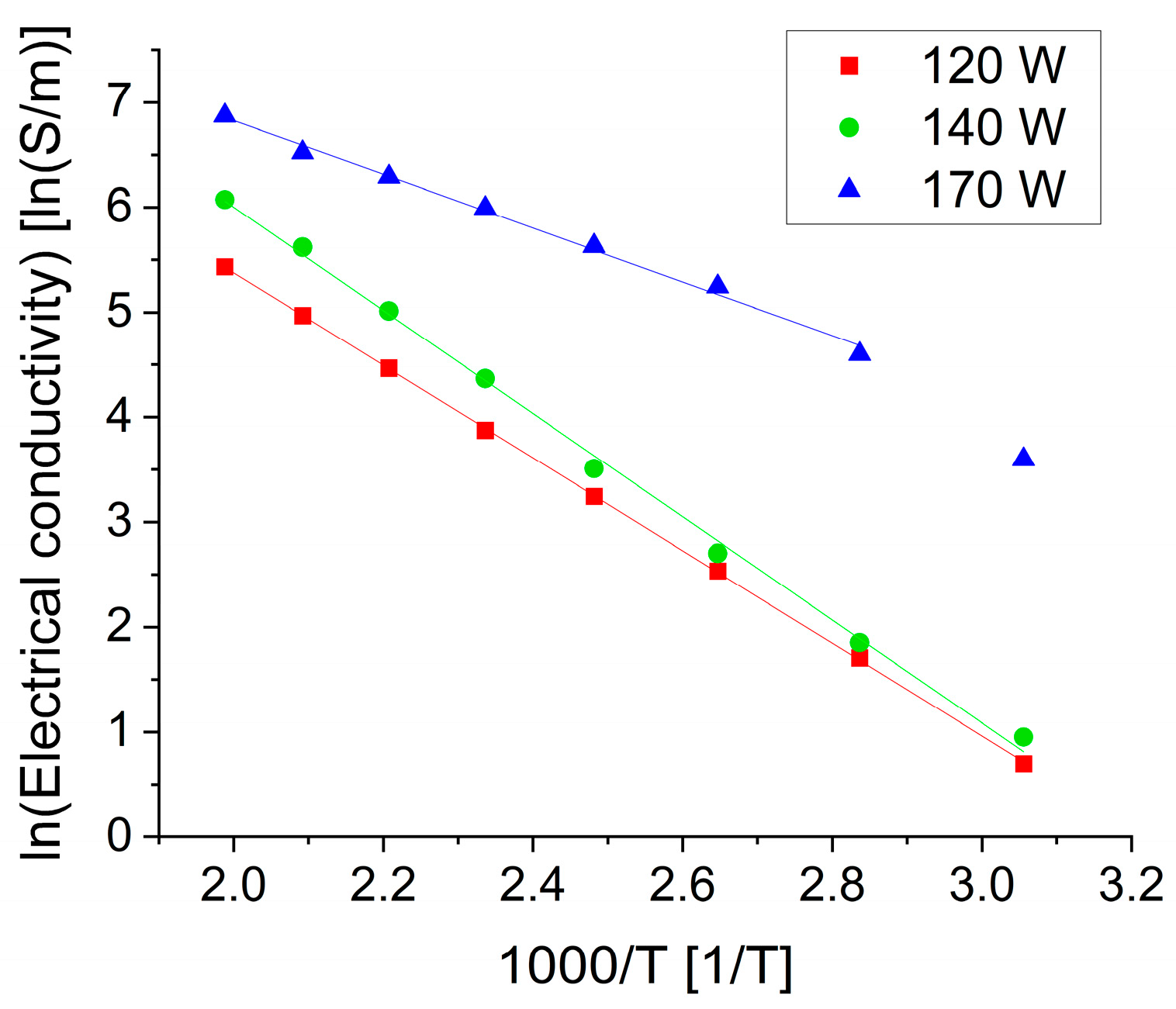



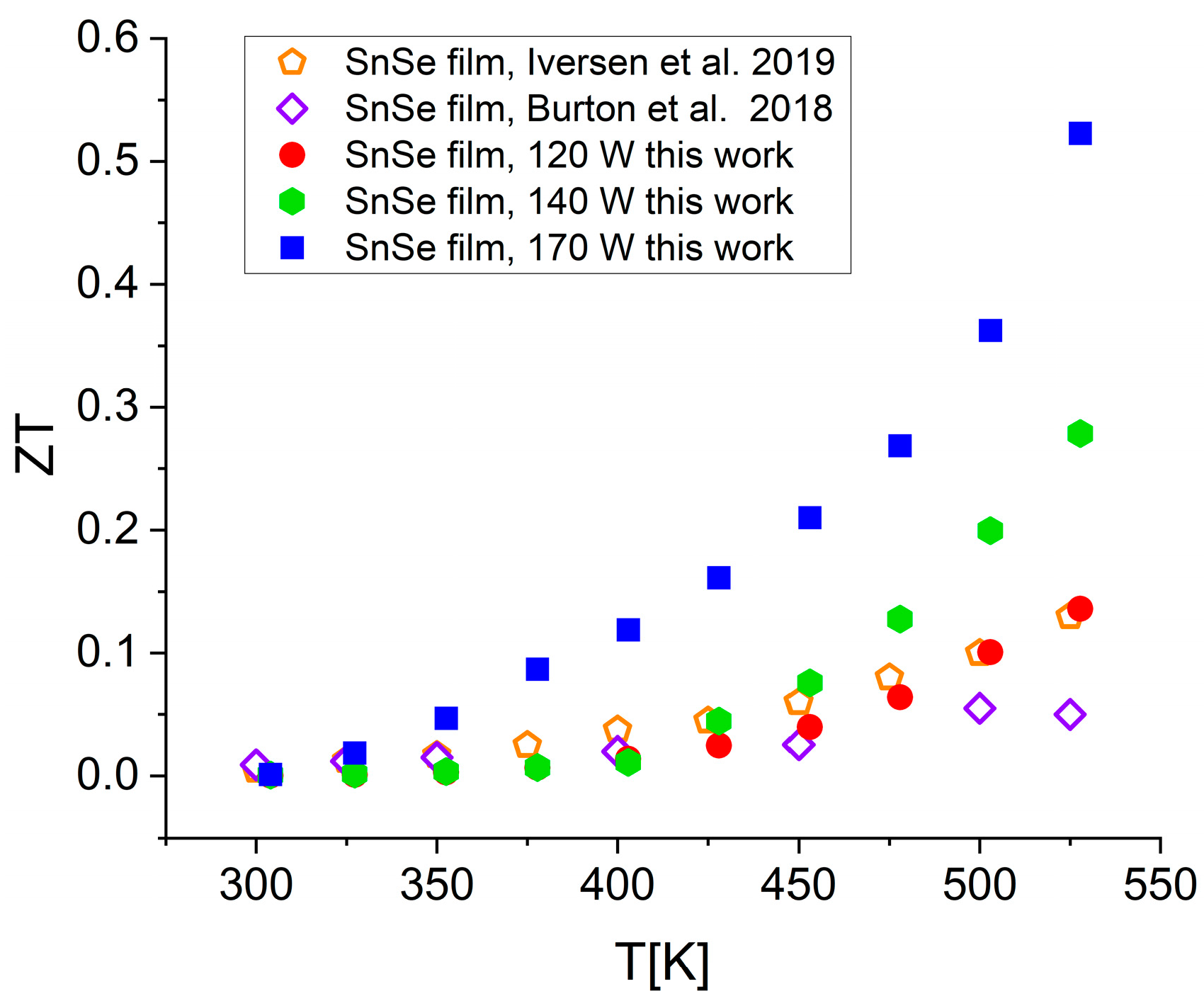

| Sample Name | Sputtering Power (W) | Film Thickness (nm) | Time (min) | Argon Pressure (mbar) |
|---|---|---|---|---|
| SnSe 120 W | 120 | 133 | 20 | 1.5 × 10−3 |
| SnSe 140 W | 140 | 220 | 20 | 1.5 × 10−3 |
| SnSe 170 W | 170 | 310 | 20 | 1.5 × 10−3 |
| Sample Name | Se (at. %) | Sn (at. %) |
|---|---|---|
| SnSe 120 W | 53.6 ± 7.2 | 46.4 ± 6.5 |
| SnSe 140 W | 50.1 ± 6.8 | 49.9 ± 4.2 |
| SnSe 170 W | 49.6 ± 6.6 | 50.4 ± 3.8 |
| Sample Name | Film Thickness (nm) | ZT (-) | PF (µW/cmK2) | Electrical Conductivity (S/m) | Seebeck Coefficient (μV/K) | Thermal Conductivity (W/mK) |
|---|---|---|---|---|---|---|
| SnSe 120 W | 133 | 0.13 | 0.98 | 331 | 559 | 0.38 |
| SnSe 140 W | 220 | 0.28 | 1.91 | 605 | 562 | 0.36 |
| SnSe 170 W | 310 | 0.52 | 3.85 | 1232 | 559 | 0.39 |
| Iversen et al. [16] | 650 | 0.13 | 1.45 | 589 | 500 | 0.65 |
| Burton et al. [22] | ~1000 | 0.05 | 0.11 | 255 | 210 | 0.12 |
| Monocrystalline (b axis) [1] | bulk | 0.18 | 1.6 | 512 | 566 | 0.47 |
| Polycrystalline [25] | bulk | 0.03 | 0.42 | 227 | 433 | 0.80 |
Disclaimer/Publisher’s Note: The statements, opinions and data contained in all publications are solely those of the individual author(s) and contributor(s) and not of MDPI and/or the editor(s). MDPI and/or the editor(s) disclaim responsibility for any injury to people or property resulting from any ideas, methods, instructions or products referred to in the content. |
© 2024 by the authors. Licensee MDPI, Basel, Switzerland. This article is an open access article distributed under the terms and conditions of the Creative Commons Attribution (CC BY) license (https://creativecommons.org/licenses/by/4.0/).
Share and Cite
Mars, K.; Sałęga-Starzecki, M.; Zawadzka, K.M.; Godlewska, E. Influence of Sputtering Power on the Properties of Magnetron Sputtered Tin Selenide Films. Materials 2024, 17, 3132. https://doi.org/10.3390/ma17133132
Mars K, Sałęga-Starzecki M, Zawadzka KM, Godlewska E. Influence of Sputtering Power on the Properties of Magnetron Sputtered Tin Selenide Films. Materials. 2024; 17(13):3132. https://doi.org/10.3390/ma17133132
Chicago/Turabian StyleMars, Krzysztof, Mateusz Sałęga-Starzecki, Kinga M. Zawadzka, and Elżbieta Godlewska. 2024. "Influence of Sputtering Power on the Properties of Magnetron Sputtered Tin Selenide Films" Materials 17, no. 13: 3132. https://doi.org/10.3390/ma17133132






